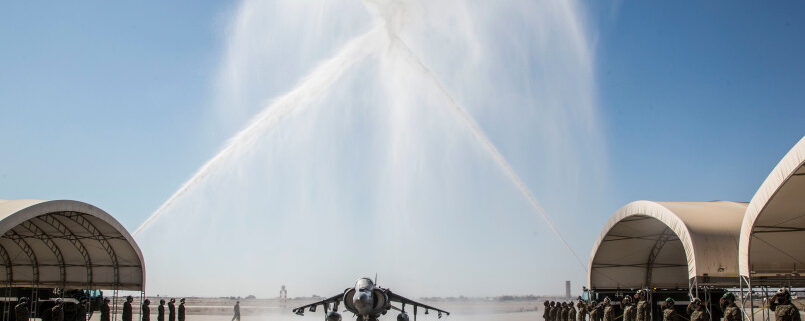Storied Marine squadron ‘sunsets’ will join new Miramar group flying F-35s
In a final sundown celebration, Lt. Col. Keith Bucklew took an AV-8B Harrier II on its last flight into the skies over Marine Corps Air Station Yuma.
When Bucklew, the commanding officer of Marine Attack Squadron (VMA) 311, landed, he and the plane were sprayed with water in a tradition all pilots cherish as the symbol of an end of an era.
The ceremony, held on Oct. 15, ended the service of the squadron known as the Tomcats. During the ceremony, VMA-311 cased their squadron colors and the National Ensign, commemorating nearly eight decades as an integral force in 3rd Marine Aircraft Wing’s forward presence around the globe. But its service will begin anew in 2022 when the squadron merges with another as the Black Sheep to fly the Marine’s new F-35B Lightning II out of Marine Corps Air Station Miramar.
The Tomcats have a proud history dating back to 1942. Since being commissioned as a fighter attack squadron, the Tomcats have taken part in multiple conflicts, including the island-hopping campaigns of World War II and the first jet combat mission in 1950 during the Korean War.
In 1988 and 1991, the Tomcats were named Marine Corps Aviator Association’s Attack Squadron of the Year. The squadron was the first to fly a Harrier in combat during Desert Storm, and later flew during the War on Terror in Iraq and Afghanistan.
“The reputable Tomcats have an exceptional level of esprit de corps representing 78 years of superior performance,” said Sgt. Maj. Colin Barry. “The Tomcats imbued a level of morale within each other that was unmatched.”
Barry said he has “no doubt” the future Black Sheep “will continue performing remarkably.”
The squadron joins others at Miramar that have already begun the transition to flying the F-35B – one of three aircraft types in the Pentagon’s trillion-dollar F-35 Joint Strike Fighter weapons program, replacing the aging Harrier, F/A-18 Hornet and EA-6B Prowler.
The Marines are incorporating the aircraft in the new vision for the military branch as a more nimble and stealth force.
The F-35s give pilots greater access to real-time information about the “battlespace,” with a 360-degree view and sensors that provide information from the air and ground. Sensors also can send information to commanders in the field and back in the U.S.
The deactivation of the Tomcats leaves only just one Harrier squadron left in the Yuma-based Marine Aircraft Group 13.






